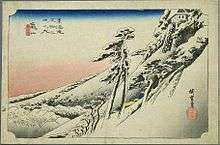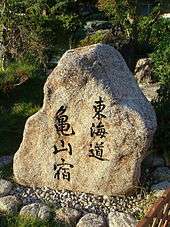Kameyama-juku

Kameyama-juku in the 1830s, as depicted by Hiroshige in the Hōeidō edition of The Fifty-three Stations of the Tōkaidō (1831–1834)
Kameyama-juku (亀山宿 Kameyama-juku) was the forty-sixth of the fifty-three stations (shukuba) of the Tōkaidō. It is located in former Ise Province in what is now part of the city of Kameyama, Mie Prefecture, Japan.
History
During the Edo period, Kameyama-juku served as both a post town and a castle town for Kameyama Castle. There are many buildings still remaining of both the post and castle town today.[1]

Kameyama-juku monument
The classic ukiyo-e print by Andō Hiroshige (Hōeidō edition) from 1831–1834 depicts travelers climbing a steep snow-covered hillside to the entrance of Kameyama Castle, which appears to be towering over the post station village.
Neighboring post towns
- Tōkaidō
- Shōno-juku - Kameyama-juku - Seki-juku
References
- ↑ Kanko: Shiseki Archived 2007-12-14 at the Wayback Machine.. City of Kameyama. Accessed December 18, 2007.
Further reading
| Wikimedia Commons has media related to Kameyama-juku. |
- Carey, Patrick. Rediscovering the Old Tokaido:In the Footsteps of Hiroshige. Global Books UK (2000). ISBN 1-901903-10-9
- Chiba, Reiko. Hiroshige's Tokaido in Prints and Poetry. Tuttle. (1982) ISBN 0-8048-0246-7
- Taganau, Jilly. The Tokaido Road: Travelling and Representation in Edo and Meiji Japan. RoutledgeCurzon (2004). ISBN 0-415-31091-1
This article is issued from
Wikipedia.
The text is licensed under Creative Commons - Attribution - Sharealike.
Additional terms may apply for the media files.